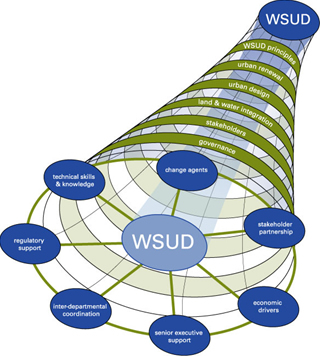|
|
|
Project 2: Policy and Organisational Receptivity
Key messages
- Part of FAWB's work on industry capacity assessment and improvement for biofilter technologies
Key Research Objectives
Key objectives were to:
- Assess how then current administrative frameworks both constrain and enable the uptake of biofilter technologies
- Identify the necessary ‘institutional qualities’ that would effectively expedite the adoption of biofilter technologies in practice
- Determine how to adapt existing reform processes and ideas to best advance the change needed
- Deliver practical guidance to urban water managers and policy makers
Mapping Industry Capacity for WSUD
This research aimed to assess the institutional factors that influence the opportunities and constraints within organisations for the implementation of Water Sensitive Urban Design (WSUD) technologies, of which biofilters are one. The strength and relative importance of the relationships and inter-linkages between these factors differ between organisational types. These factors were investigated and mapped for industry sectors to determine the then current institutional capacity trends for WSUD technologies.
Barriers and drivers to ‘Sustainable Urban Water Management’
In complementary research involving the FAWB Project 2 team, the National Urban Water Governance Program conducted an on-line survey in November 2006. The questionnaire focused on perceived ‘barriers’ and ‘drivers’ to advancing sustainable urban water management in three case study regions: Melbourne, Brisbane and Perth.
The questionnaire was aimed at range of stakeholders, but specifically urban water professionals. The questionnaire response was overwhelming with over 300 respondents in Perth and Brisbane and over 420 in Melbourne (n=1041).
Further details are available at: Centre for WA
(As at April 2007)
- The WSUD approach is yet to be mainstreamed anywhere, and the mainstreaming of WSUD will require a more complex multi-sectoral governance approach that is dedicated, proactive and strategic in its pursuit of WSUD. This is because there is currently an absence of an overriding and galvanising socio-political driver or 'crisis' to drive the necessary change.
- There is a need to provide guidance to urban water strategists and others on how to enable effective institutional change that will lead to the mainstreaming of the WSUD approach across modern cities.
- The retrospective social research analysis of the of the key factors over the last 40 years that has enabled the successful institutionalisation of 'urban stormwater quality management' across Metropolitan Melbourne reveals: how the 'value' of environmental protection of waterways has been institutionalised towards a relatively advanced stage of increasing importance, within the broader set of well established institutional values of flood protection, public health protection, water supply security and economic efficiency within current decision and policy-making processes.
- While the historical case study research revealed a range of interconnected activities and initiatives that on the surface seem to represent an organic development pathway, there has been a critical, and in many ways opportunistic, interplay between industry champions and important context variables that has provided the structure and catalyst for the transition so far.
- Eight key context variables are identified as instrumental when considered as a 'package' to advancing institutional change.
|
No.
|
Key Variables
|
Description
|
|
1
|
Socio-Political Capital
|
Aligned community, media and political concern for improved waterway health, amenity and recreation.
|
|
2
|
Bridging Organisation
|
Dedicated organising space that facilitates collaboration across science and policy, agencies and professions, and knowledge brokers and industry.
|
|
3
|
Trusted & Reliable Science
|
Accessible scientific expertise, innovating reliable and effective solutions to local problems.
|
|
4
|
Binding Targets
|
A measurable and effective target that binds the change activity of scientists, policy makers and developers.
|
|
5
|
Accountability
|
A formal organisational responsibility to the improvement of waterway health, and a mandate for influencing practices that lead to such an outcome.
|
|
6
|
Strategic Funding
|
Additional resources dedicated to the change effort.
|
|
7
|
Demonstration Projects & Training
|
Accessible and reliable demonstration of new thinking and technologies in practice, accompanied by knowledge diffusion initiatives.
|
|
8
|
Market Receptivity
|
A well articulated business case for the change activity.
|
- The insights from the Melbourne case study provide an important basis for other cities, and other sectors of activity, to learn from.
- While the institutional dynamics of the WSUD approach may be more complex than those for the urban stormwater quality management (USQM) approach, the Melbourne case study provides a solid platform of evidence for how institutional change can successfully occur and identifies key factors that underpin such change.
Project 1 | Project 2 | Project 3 | Project 4
|


